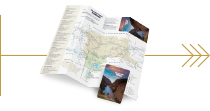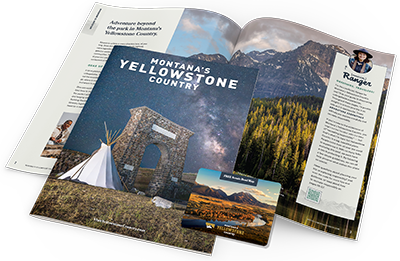The answer is, anytime. Each season holds something unique to discover, from the Great American Summer Vacation to a wonderland of winter’s peace and tranquility.
SUMMER
THE PARK’S MOST POPULAR, SUNNY SEASON
Best for: The classic Yellowstone experience, good weather
General weather: Sunny, warm, chilly nights
Summer rumbles into Yellowstone slowly. Seasonal Park amenities start opening in late April, with most amenities opening in May and a few stragglers in June. “Real” summer (sunshine, shorts-weather and crowds) starts in late June.
While the summer sun can be intense, highs usually range in the 70s and 80s, falling to lows around 30 and 40 at night. Afternoon thunderstorms are common, but usually brief. Still, Yellowstone has seen snow in even July and August (albeit fleeting snow).
The park hosts the most visitors in July, with August close behind. These two months welcome almost half of the Park’s annual visitors. Book everything—lodging, backpacking permits, trail rides and raft guides—ahead.
Learn More About Summer
FALL
LOCAL’S FAVORITE SHOULDER SEASON
Best for: Lighter crowds, good (but cooler) weather, cold nights
General weather: Crisp days, cold nights, occasional flurries
By mid-September, some seasonal park amenities (like service stations and some campgrounds) begin shuttering up. By the first few days in November, all seasonal services and many park roads close for the winter. Still, fall can be the perfect time to visit, with the Aspens turning gold, elk bugling, crisp blue skies and fewer visitors.
The adage is dress for both summer and winter in fall—days can be pleasant (or not) and nights can get below freezing. September snow isn’t unheard of, but late October holds a more likely possibility for the white stuff. No need to bring skis or snow boots yet—most blizzards at this time of year melt away quickly.
September sees about half the visitors of July, and October sees only a fraction.
Learn More About Fall
WINTER
THE PARK’S LEAST-VISITED, MOST UNIQUE SEASON
Best for: Solitude, independent travelers, back-home bragging rights
General weather: Cold, snow, blizzards to blue skies
In winter, Yellowstone is open. We repeat: Yellowstone is open. All of it. The confusing part is, you can’t drive through most of it. But, a bevvy of snowcoach operators, snowmobile tours, Nordic ski tours and the one drivable road provide access into the park to see extra-steamy geysers, prolific wildlife and a landscape turned sparkling white.
On a winter weekday, you may only encounter a handful of other visitors, especially if you travel via skis or snowshoes. Only the minimum park services are open—pit toilets, a few visitor centers and warming huts, so you’ll want to pack lunches and be self-reliant (and safe). The North Entrance, near Gardiner, and the Northeast Entrance, near Cooke City, are both open, allowing for traffic along the road through the Lamar Valley, via Mammoth and Tower Junction.
Plan for the worst, in terms of winter conditions, but hope for sunny bluebird days. Temperatures can drop below freezing and into the single digits, with some subzero days, or it can get as high as 40s and 50s, with bright sunshine. While it’s not the everyday norm, there’s a potential for whiteout blizzards from November to April.
Learn More About Winter
SPRING
THE WILDEST SHOULDER SEASON
Best for: Baby wildlife, no crowds, late-season snowsports, early-season hiking and biking
General weather: Winter-like, chilly springtime
We won’t even try to predict spring weather, but most years the snow in Yellowstone clings through April, and in higher elevations, through May and even into June. The park closes to oversnow travel (snowcoaches and snowmobiles) in early March. In mid-April, park roads begin to open, with the last road opening in early June. Park amenities also begin opening in mid-April and May, with just a few holdouts opening in June.
The slow wakeup from winter creates excellent opportunities for solitude lovers, depending on weather: biking, skiing and snowshoeing, early-season hiking and wildlife watching. As with winter, bring your own snacks and picnic lunches into the park and plan to be fairly self-sufficient.
Watch the weather channel and prepare for anything—from dead-of-winter conditions (usually April and sometimes May) to sunny spring days in the 60s (probably not till May, but spring can be fickle).
Learn More About Spring




